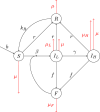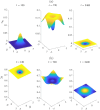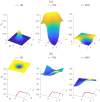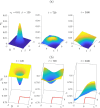The effects of spatially-constrained treatment regions upon a model of wombat mange
- PMID: 38565734
- PMCID: PMC10987376
- DOI: 10.1007/s00285-024-02078-9
The effects of spatially-constrained treatment regions upon a model of wombat mange
Abstract
The use of therapeutic agents is a critical option to manage wildlife disease, but their implementation is usually spatially constrained. We seek to expand knowledge around the effectiveness of management of environmentally-transmitted Sarcoptes scabiei on a host population, by studying the effect of a spatially constrained treatment regime on disease dynamics in the bare-nosed wombat Vombatus ursinus. A host population of wombats is modelled using a system of non-linear partial differential equations, a spatially-varying treatment regime is applied to this population and the dynamics are studied over a period of several years. Treatment could result in mite decrease within the treatment region, extending to a lesser degree outside, with significant increases in wombat population. However, the benefits of targeted treatment regions within an environment are shown to be dependent on conditions at the start (endemic vs. disease free), as well as on the locations of these special regions (centre of the wombat population or against a geographical boundary). This research demonstrates the importance of understanding the state of the environment and populations before treatment commences, the effects of re-treatment schedules within the treatment region, and the transient large-scale changes in mite numbers that can be brought about by sudden changes to the environment. It also demonstrates that, with good knowledge of the host-pathogen dynamics and the spatial terrain, it is possible to achieve substantial reduction in mite numbers within the target region, with increases in wombat numbers throughout the environment.
Keywords: Mathematical model; Sarcoptic mange; Spatial variation; Terrain knowledge; Treatment; Wombats.
© 2024. The Author(s).
Conflict of interest statement
No conflict of interest exist.
Figures














Similar articles
-
Host, environment, and anthropogenic factors drive landscape dynamics of an environmentally transmitted pathogen: Sarcoptic mange in the bare-nosed wombat.J Anim Ecol. 2023 Sep;92(9):1786-1801. doi: 10.1111/1365-2656.13960. Epub 2023 May 23. J Anim Ecol. 2023. PMID: 37221666
-
Fine-Scale Landscape Epidemiology: Sarcoptic Mange in Bare-Nosed Wombats (Vombatus ursinus).Transbound Emerg Dis. 2023 Mar 4;2023:2955321. doi: 10.1155/2023/2955321. eCollection 2023. Transbound Emerg Dis. 2023. PMID: 40303715 Free PMC article.
-
The effect of spatial dynamics on the behaviour of an environmentally transmitted disease.J Biol Dyn. 2022 Dec;16(1):144-159. doi: 10.1080/17513758.2022.2061614. J Biol Dyn. 2022. PMID: 35404769
-
Sarcoptic mange in wombats-A review and future research directions.Transbound Emerg Dis. 2018 Apr;65(2):399-407. doi: 10.1111/tbed.12770. Epub 2017 Nov 18. Transbound Emerg Dis. 2018. PMID: 29150905 Review.
-
Pharmacokinetic and pharmacodynamic considerations for treating sarcoptic mange with cross-relevance to Australian wildlife.Int J Parasitol Drugs Drug Resist. 2023 Apr;21:97-113. doi: 10.1016/j.ijpddr.2023.02.004. Epub 2023 Mar 5. Int J Parasitol Drugs Drug Resist. 2023. PMID: 36906936 Free PMC article. Review.
References
-
- Astorga F, Carver S, Almberg ES, Sousa GR, Wingfield K, Niedringhaus KD, Van Wick P, Rossi L, Xie Y, Cross P, Angelone S, Gortázar C, Escobar LE (2018) International meeting on sarcoptic mange in wildlife, June 2018, Blacksburg, Virginia, USA. Parasites and Vectors, vol 11, p 449. 10.1186/s13071-018-3015-1 - PMC - PubMed
-
- Banks SC, Skerratt LF, Taylor AC. Female dispersal and relatedness structure in common wombats (Vombatus ursinus) J Zool Lond. 2002;256:389–399. doi: 10.1017/s0952836902000432. - DOI
MeSH terms
Supplementary concepts
LinkOut - more resources
Full Text Sources
Medical

